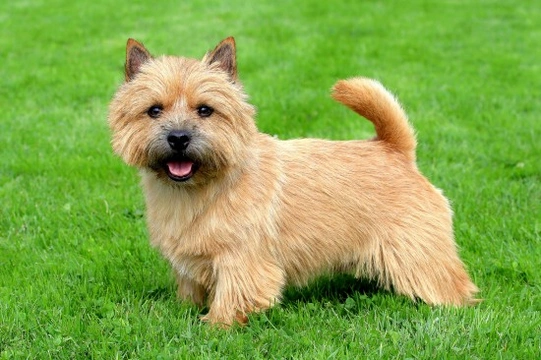
Norwich terrier hereditary health and longevity
The Norwich terrier is a small dog breed, which along with the closely related Norfolk terrier, is classed as the smallest of all of the working terrier breeds. The only obvious difference between the Norwich terrier and the Norfolk terrier breeds is that the Norwich terrier has pricked ears while the Norfolk terrier has drooping ears, and up until 1960, the two breeds were classed as one and the same!
Originally bred as a working dog and mainly used as a ratter, today the Norwich terrier is most widely kept as a pet. They are not among the most common of dog breeds, partially due to the small litter sizes that bitches of the breed tend to produce, leading to a relatively high purchase price for puppies when compared to similar breeds.
The Norwich terrier stands up to 10” high at the withers, and can weigh up to 5.4kg. They are classed within the terrier grouping rather than as a toy breed, due to their superior working ability and strong history as working dogs. They have wiry, double layered coats that can be seen in either black and tan, tan, wheaten, red or grizzle, and which are reasonably low maintenance to care for.
If you are wondering if the Norwich terrier is the right choice of pet for you, you may have to wait some time and be prepared to travel some distance in order to find a litter with pups for sale! In the interim, it is important to do plenty of research on the breed before committing to a purchase, including looking into the hereditary health and general wellness of the breed as a whole. We will cover these factors in more detail within this article.
Norwich terrier average longevity
The average lifespan of the Norwich terrier is 12-16 years, which provides a reasonable amount of variance.
Even at the lower end of the average, 12 years is considered to be firmly in the middle of the rankings across the board of all similar sized breeds, while at the top end of the scale, the lifespan of the oldest Norwich terriers is much higher than normal.
Norwich terrier genetic diversity
The coefficient of inbreeding statistic for the Norwich terrier breed as a whole is 8.1%, which is slightly higher than the accepted ideal of 6.25% or lower. A degree of inbreeding is somewhat necessary in order to keep the Norwich terrier breed viable in perpetuity, due to the small litter sizes that the breed is known for, and so, the relatively small number of dogs of the breed extant.
However, a high degree of inbreeding can itself contribute to small litter sizes, and so breeders of the Norwich terrier are advised to reduce the coefficient of inbreeding statistic within their own breed lines where possible.
Conformation
The shape and build of the Norwich terrier is considered to be well balanced and proportionate, and not prone to any exaggerations that may affect the health or quality of life of the breed. They are not subjected to overtyping, and generally are considered to be a good example of a fit, healthy working terrier breed.
Health testing
Like the closely related Norfolk terrier, the Norwich terrier is fairly unusual insomuch as that there are no pre-breeding screening schemes or recommended health testing schemes in place for dogs of the breed. This indicates that the Norwich terrier is a generally robust and healthy dog that is not apt to suffer from a high incidence rate of hereditary health problems that may affect their quality of life or shorten their lifespans. This is reflected within the relatively long average lifespan of dogs of the breed.
Health issues
While the Norwich terrier is widely considered to be a robust and healthy little dog that is a good example of a healthy genetic background and breeding process, like all dogs, certain health issues have been found to present themselves within the Norwich terrier breed pool.
Potential Norwich terrier owners should make themselves aware of the following health conditions that may potentially affect dogs of the breed, and which have a hereditary element to them.
- Lens luxation, an eye condition that causes the lens to become displaced from its normal position.
- Cataracts of the eyes, particularly in maturity. However, these are often operable in order to preserve the dog’s vision.
- Patellar luxation, a condition that can affect the kneecaps. This condition occurs when the muscles and ligaments that hold the kneecaps in place are not strong enough for the job, leading to the slipping and dislocation of the kneecap.
- An elongated soft palate, which may lead to a breathing problem known as upper airway syndrome.
- Heart murmurs also affect some dogs of the breed, which may ultimately lead to progressive heart failure.
- Epileptoid cramping syndrome, a condition that causes muscle spasms and fits without an associated loss of consciousness.



